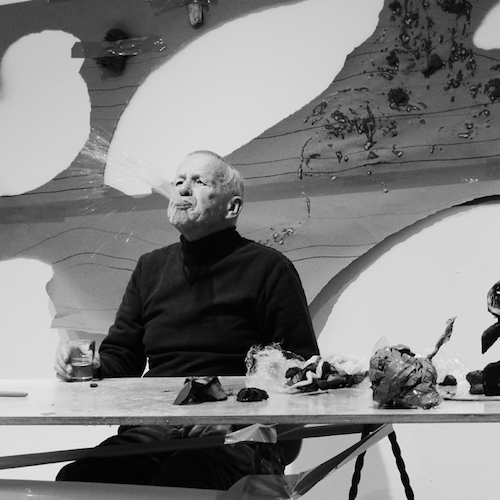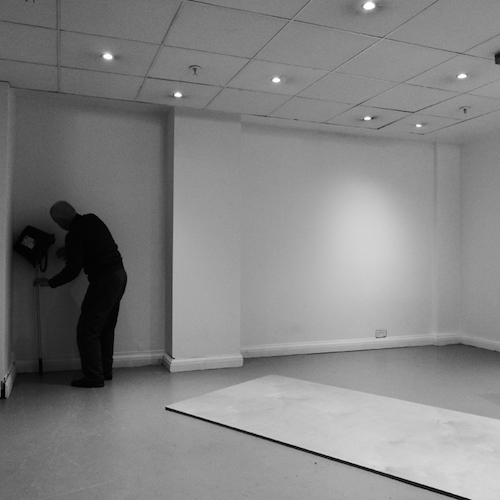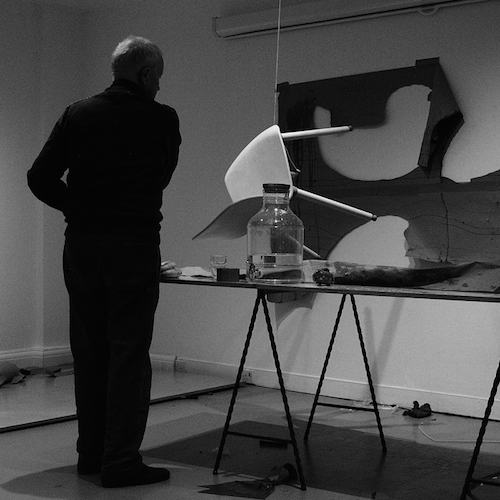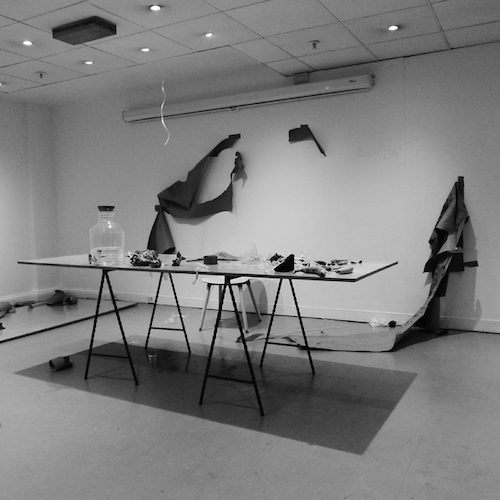



17.2.2018
Turf Projects Croydon
Interregnum 11:30 - 16:30 (with two breaks)
This work is titled under the term Interregnum. As an example it describes the gap in the continuity of monarchy, occupied by the English Revolution between 1642 -1688. There are contemporary examples. This is where we are.
The following text does not presume to be an analysis of Interregnum. I am not in a position to see myself as a performer. I aim to provide some observations which together with visual imagery might give some sense of this performance and some general views and observations.
Resistance
From the sublime morphing into.
Interregnum (Croydon 2018)
The action took place at Turf Projects situated in the Whitgift Centre in Croydon South London as part of an exhibition.
Materials ordered: black marker pens, cling film, brown wrapping paper, bananas.
Other materials and tools available: Water from the tap.
Furniture: Two identical tables, a chair, a bucket and mop, two rolls of parcel tape.
A Japanese penknife (mine)
There was access to a modest room holding a miscellany of objects: tools, paint, paper, ladders, boxes, brooms, children’s sculptures etc.
Children’s sculptures
On a visit to see the space at Turf Projects I saw a dozen or so small sculptures made by children on a table. It was agreed that they could be made available.
The use of language
Through body behaviour I implied and occasionally voiced a transformation of materials from habitual usage into more offensively provocative visual imagery.
Analogy: turning wine into vinegar. Turning brown paper into shit, bananas into vomit, spitting out saliva, cling film into a tape worm by the use of speech.
Invitation to audience
By occasionally offering bananas to the audience I entered into a casual daily living exchange thereby sometimes breaking the continuity of the performance.
Two sculptures were placed on the table and were moved now and again. One about 20 centimetres in height, a powerful human image, witch like in dark green and red colours, a baleful presence. It had the appearance of a fetish. Two were brought out during the performance and remained until passed over to the audience. Others were brought out to be given to the audience to take away with them if they wished towards the end as part of the performance.
Memory and forgetfulness
The natural proclivity to accept narrative in linear time is countermanded successfully or otherwise by the performer’s attempts to resist a unified flow of the work. Narratives will be found post event where selective characteristics of memory and forgetting combine to engage as a mental process in keeping with the linear passage of time.
Quote from the performance: “I’m doing this in the land of the free”.
What?
The performer said it deliberately to invoke the vulgar sentiment where the association of freedom with land raises the spectre of a vicious nationalism, and did not repeat it.
The performer ate two or three bananas. Eating each banana then spitting it out and eating it again and again eatingitspittingitouteatingitspittingitout
Why did the gorillas in Berlin zoo eat the vomit in 1973? eatitvomiteatitvomiteatitvomit (I saw this in 1973).
It is common knowledge that apes are genetically closely related to homo sapiens. The performer (in me) was speaking to himself while being aware that the audience was within hearing distance. The suggestion being that we are intimately connected to the natural world, we are part of it. We might see that the conscious dysfunctional behaviour of the performer may be connected to our closest common ancestor whose own dysfunctional behaviour was clearly affected by imprisonment, however humane. Later, towards the completion of the performance banana juice and soft body were used as glue and paint.
The performer took mouthfuls of water and spat them out on several occasions.
He ate pieces of brown paper and spat and spat out chewed lumps and called them shit more than once.
Why did he do that?
Some things are hard to take.
Spitting in the street is not uncommon
Spitting is a shamanistic behaviour where phlegm is brought up and spat out, which is believed to have magic qualities. The performer however is more concerned with spitting as a behaviour which is found in most if not all societies.
A disabled ex miner showed his smashed up leg and relayed the events of a pit accident. Lying on the ground partly crushed by the large stone when the roof collapsed on him. As he lay there he spat mouthfuls of water up into the air.
The performer chewed pieces of brown wrapping paper and tried to speak. He spat out chewed lumps and called them shit more than once.
Repetition
The breaks were established as the work progressed. However, repetition was considered beforehand as part of the performance structure.
More or less everything in performance acts against the idea of repetition when it is assumed to be a simple mechanical process. Repetition as a tactic has clarity in marking time. It appears not to change when everything around it does, but as an item in the general accumulation of moments involving the memory, it is susceptible to interpretation once memory is brought to bear, acting selectively when confronted with the panoply of elements, making up what might constitute a performance.
Surface
I see the idea of surface as a condition of engagement, analogous to the ground of everyday life. In this performance it is those exchanges e.g. offering food, talking in the presence of the audience etc, which connect the performer to the audience seemingly casually, outside the thrust of the work. These actions punctured the performance. It was as though the performer stepped beyond the parameters set by performance in these moments. Conversely from the perspective of the audience, these moments could be sensed and/or understood where the audience became part of the performance.
Power of the audience
Power is a condition which speaks of an unconscious drive. That is not to say that the performance derives solely from the unconscious. Reason is underpinned by the unconscious part of our make up.
We (performer and audience) stand on the same ground literally butted up together. When the performer stands in the performing space he/she is metaphorically in a different condition which bestows power on to the performer. If the performer steps away from the space, either the power ceases to exist, or through the act of performing the space becomes another part of the performance space. The spaces or parts of them may be changed by either party in the course of the performance. The audience has another power which is determined by numbers in the audience. In the course of the performance the audience acts as a singular body which will affect the performance. Simply put without an audience there can be no performance. Individuals in the audience have their own power but as an audience their individuality is subdued when the audience acts as a singular body. It is the power which groups of people show in other circumstances as e.g. mob, crowd, audience etc. When collective power arises it is that force which combines with the power of the performer. It is power which may express engagement or be expressed in negatively. This is a fundamental element among the attributes of performance.
The performer
To begin with, as mentioned above, the space of the performance gives power to the performer, just as the stage does in theatre. And as mentioned above, the audience by the fact of its existence can either empower or diminish the power and therefore the role of the performer.
In this work the audience complemented the performance and completed it. As a performer one can sense their contribution whereas I (the performer) am unable to fully understand my own contribution. But I can sense when there is a positive compatibility between myself and an audience. The performance comes and goes or rises and falls in its qualities as the process of repetition turns, and turns again. As the performer I cannot see my body language, but when the performance feels positive I can only hope that the unconscious drive of the body is in sympathy with what is happening. I was able to identify an emerging pattern to the series of actions, some unique, others repetitious. As the work proceeds I slowly become aware of mistakes I try not to repeat them. What emerged in this work? This is my interpretation and by its very nature, partial.
The pattern
In the latter stages I made up a working surface of sheets of brown paper and glued them to to the wall to make one rectangle. It was placed in front of a trestle table on which resided the two small fetishes (children’s sculptures) mentioned earlier, and some other bits and pieces. The brown paper sheet was approximately the same size as the table top, may be a little larger. I made some horizontal lines using four or five marker pens simultaneously, smeared banana substance to the sheet and tore some holes. I chewed pieces of brown paper until they were malleable and then threw them with some force at the emergent imagery. At this later stage I was beginning to clear the ground of detritus to allow the work to resonate (breathe) where the paper work could seen to be analogous to the developing nature of the work itself in relation to the title Interregnum. Or so I thought.
I saw and tried to bring the disparate parts together and at the same time simplify what was in front of me. What refuses to come together falls apart. My own behaviour became less overt. I became the cleanser of the imagery. And in the last few minutes I sat on a chair which had been moved towards the audience. We looked at each other. We looked at each other until a timer should have rung out marking the end of the work. But it didn’t.
The title Interregnum is generic. The performance is not descriptive. It was intended to offer a number of actions, sounds, repetitions, bodily behaviour; where everything present and passing could be taken into account, including the characteristics of the space, the age of the performer, and the physical attributes, the presence of the audience, In this work the endurance of the audience some of whom were present from the beginning to the end, matched that of the performer of whom it might be said led an orchestra composed of the participating audience and all and more mentioned above.
The continuity of the work lies in the minds of those present where memory plays its slippery part. I recognised some aspects, e.g. the perception that not much of what I produced was presented strictly for what it was. That is the upside down mop with its head inside the upside down bucket leaning in a corner of the room was an obvious sign which came to be there early on and stayed for the duration. Order was to be reinstated. The reference to interregnum is a general one. I should say e.g. that the meaning behind using it as a title has significance in the way the performance intervened with the daily life for a short time.
Stuart Brisley, March 2018